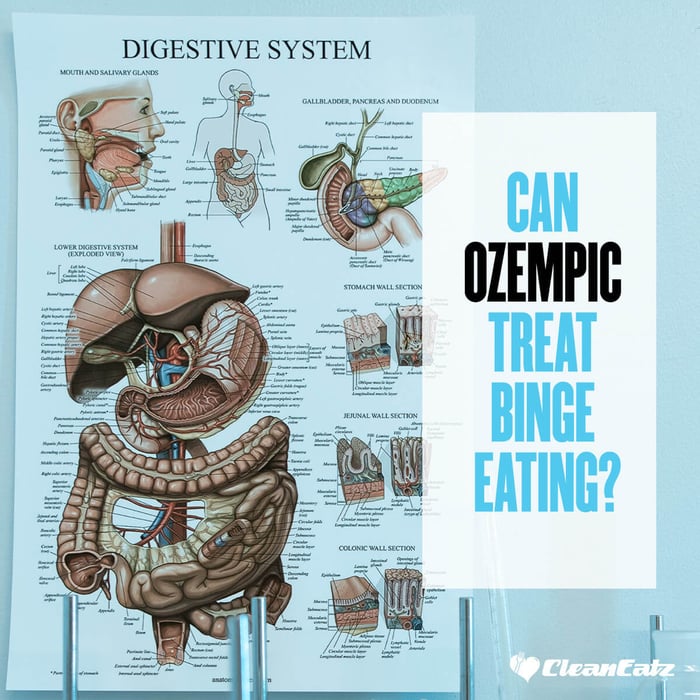Last updated: September 15, 2025
Can Ozempic Treat Binge Eating?
Quick answer: Ozempic (semaglutide) is not FDA-approved to treat binge eating disorder (BED). Early, small studies of GLP-1 drugs (mostly liraglutide and dulaglutide) suggest they may reduce binge frequency for some people, but high-quality trials are limited. The only FDA-approved medication for BED is lisdexamfetamine (Vyvanse), and cognitive-behavioral therapy for eating disorders (CBT-ED) remains a first-line treatment. If you’re considering a GLP-1, talk with an eating-disorder-informed clinician about benefits, risks, and alternatives.
What Is Binge Eating Disorder (BED)?
BED involves recurrent episodes of eating unusually large amounts of food with a sense of loss of control, plus distress and impairment. It’s the most common eating disorder and occurs across body sizes. Effective care typically combines therapy, skills-based nutrition, and sometimes medication.
Ozempic / GLP-1 Overview
- What it is: Ozempic is semaglutide, a GLP-1 receptor agonist approved for type 2 diabetes and used off-label for weight-related concerns. (Wegovy™, the higher-dose semaglutide, is approved for chronic weight management.)
- How it might help: GLP-1 drugs reduce appetite and food reward in some people, which could indirectly lessen urges to binge.
- Important: Semaglutide carries a boxed warning about rare thyroid C-cell tumors in rodents and is contraindicated with personal/family history of medullary thyroid carcinoma or MEN-2. See the label in References.
What the Evidence Says So Far
Bottom line: Early data are promising but preliminary. A 2024 systematic review found small pilot studies where GLP-1 drugs (especially liraglutide and dulaglutide) were associated with reduced binge episodes and weight, but called for large, placebo-controlled trials before routine use for BED. Semaglutide has less direct BED-specific trial data; clinicians sometimes extrapolate from related GLP-1s. Read the review.
What’s FDA-Approved for BED?
- Medication: Lisdexamfetamine (Vyvanse) is the only FDA-approved drug for moderate-to-severe BED. It can reduce binge days but is a stimulant (monitor HR/BP, sleep, anxiety).
- Therapy: CBT-ED and interpersonal therapy (IPT) have strong evidence for reducing binge frequency and distress. See APA guidance and recent CBT-ED advances in this 2024 review.
Risks, Cautions & Who Should Avoid GLP-1s
- Eating-disorder context: Appetite-suppressing meds can sometimes worsen restriction, obsession with the scale, or purging in vulnerable people. Leading orgs advise involving an ED-informed clinician. See NEDA’s advisory.
- Medical safety: GI side effects (nausea, vomiting), possible gallbladder issues; rare pancreatitis; dehydration risk; medication interactions.
- Label warning: Thyroid C-cell tumor risk (rodent data); contraindicated with personal/family history of MTC or MEN-2. See the Ozempic label (2025 update).
- Mental health: Ongoing monitoring is prudent if you have mood/anxiety disorders; report new/worsening symptoms promptly.
Smart Next Steps With Your Clinician
- Confirm the diagnosis: True BED vs. emotional eating vs. high-calorie snacking calls for different interventions. Screening and a structured interview help.
- Map priorities: Reduce binge frequency and distress first (therapy skills), then consider weight-related options if still indicated.
- Discuss all tools: CBT-ED/IPT, nutrition structure (regular meals/snacks), sleep/stress care, and—case by case—meds (Vyvanse; off-label SSRIs/topiramate; GLP-1s as experimental/adjunct under supervision).
- Safety plan: If trying a GLP-1, set check-ins (2–4 weeks initially), track binge frequency, mood, GI tolerance, hydration, and labs as indicated.
A Practical Care Plan (Non-Drug + Drug Options)
Foundations (often week 1–2)
- Regular eating: 3 meals + 1–2 planned snacks to cut “extreme hunger” binges.
- Trigger mapping: note times, emotions, and settings preceding binges; build alternatives.
- Structured groceries: keep balanced, easy meals on hand. Try our Build-a-Meal Plan to remove decision fatigue.
Therapy & Skills (weeks 2–12+)
- CBT-ED skills: urge surfing, cognitive restructuring, problem-solving, and relapse prevention.
- IPT focus: relationships, role transitions, grief/conflict patterns that drive binges.
Medication Layer (individualized)
- First consider: Lisdexamfetamine (FDA-approved for BED) if appropriate.
- Other off-label options: SSRIs (for co-occurring mood/anxiety), topiramate (monitor side effects).
- GLP-1s (experimental for BED): A trial may be considered by an ED-informed prescriber if binge frequency remains high despite first-line care, with clear goals and close monitoring.
Related CEK Guides
- Calorie Calculator: Find Your Daily Needs
- Are Protein Bars Good for Weight Loss?
- Electrolytes: Best Water Supplements
- Healthy Lifestyle Hacks
FAQs
Is Ozempic approved for binge eating disorder?
No. Ozempic (semaglutide) isn’t FDA-approved for BED. The only FDA-approved medication for BED is lisdexamfetamine (Vyvanse).
Can GLP-1 drugs reduce binge eating?
Small studies with related GLP-1s (liraglutide, dulaglutide) suggest fewer binges for some, but high-quality trials are still needed. Semaglutide has less BED-specific research.
Could a GLP-1 make my eating disorder worse?
It can if appetite suppression triggers restriction, obsession with weight, or purging. Work with an ED-informed clinician and monitor closely.
What should I try first?
CBT-ED or IPT plus a consistent meal pattern are foundational; medication choices (including Vyvanse) depend on your health profile and goals.
Are there safety warnings with Ozempic?
Yes—GI effects, gallbladder issues, rare pancreatitis, and a boxed warning about thyroid C-cell tumors (rodent data). It’s contraindicated with personal/family history of MTC or MEN-2.
Disclaimer: This article is for general information only and isn’t a substitute for medical advice. If you suspect an eating disorder—or experience urges to harm yourself—seek professional help immediately. In the U.S., call/text 988 for crisis support.




